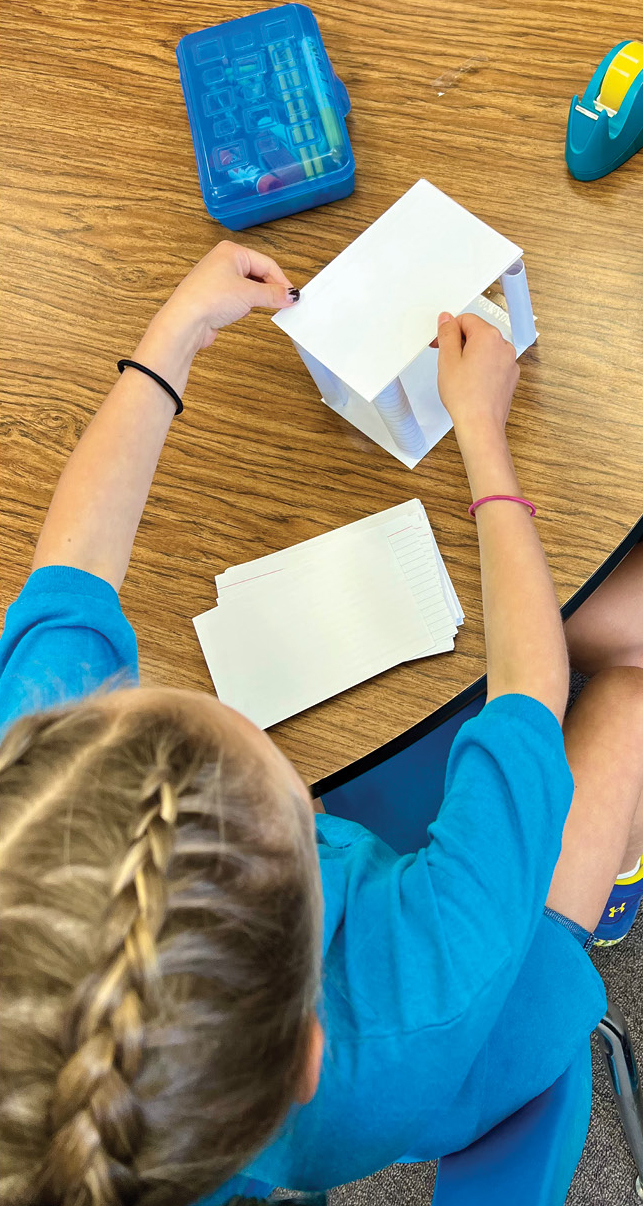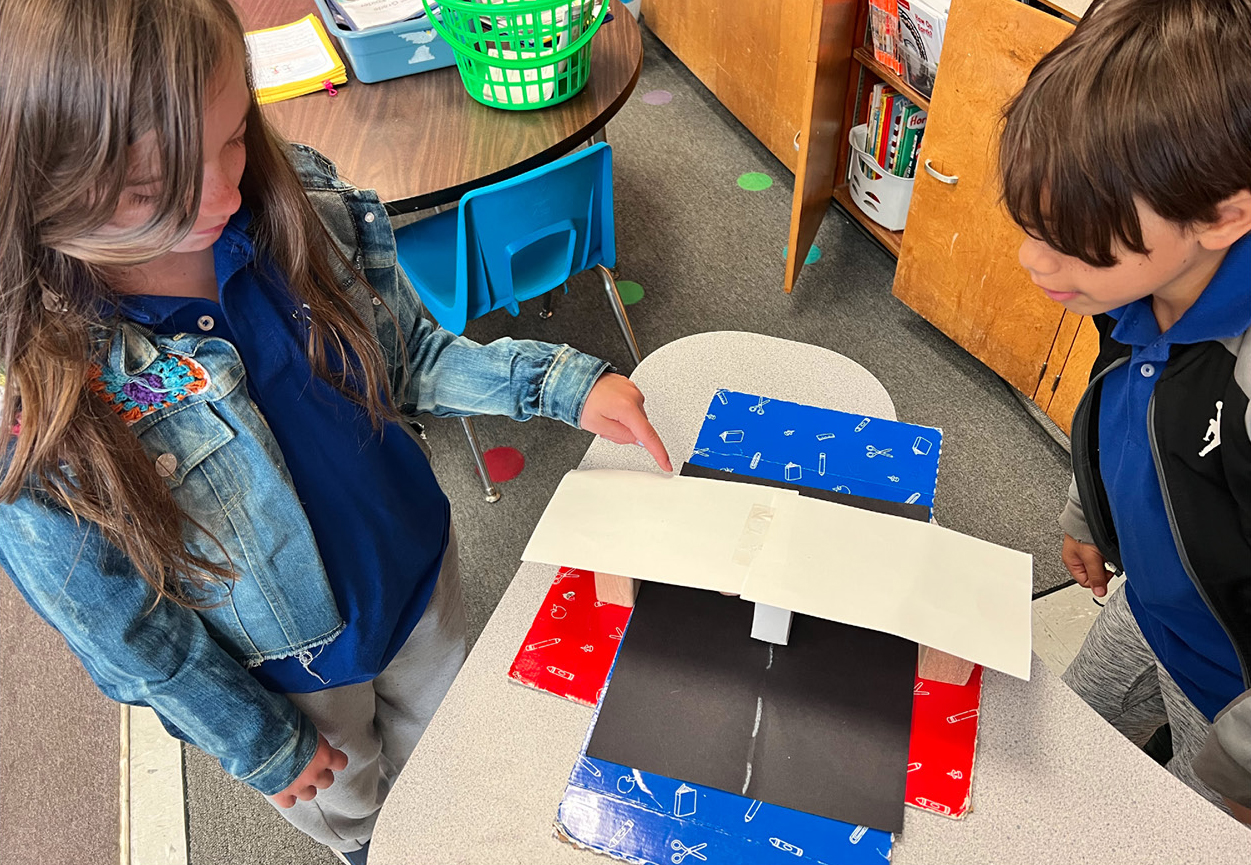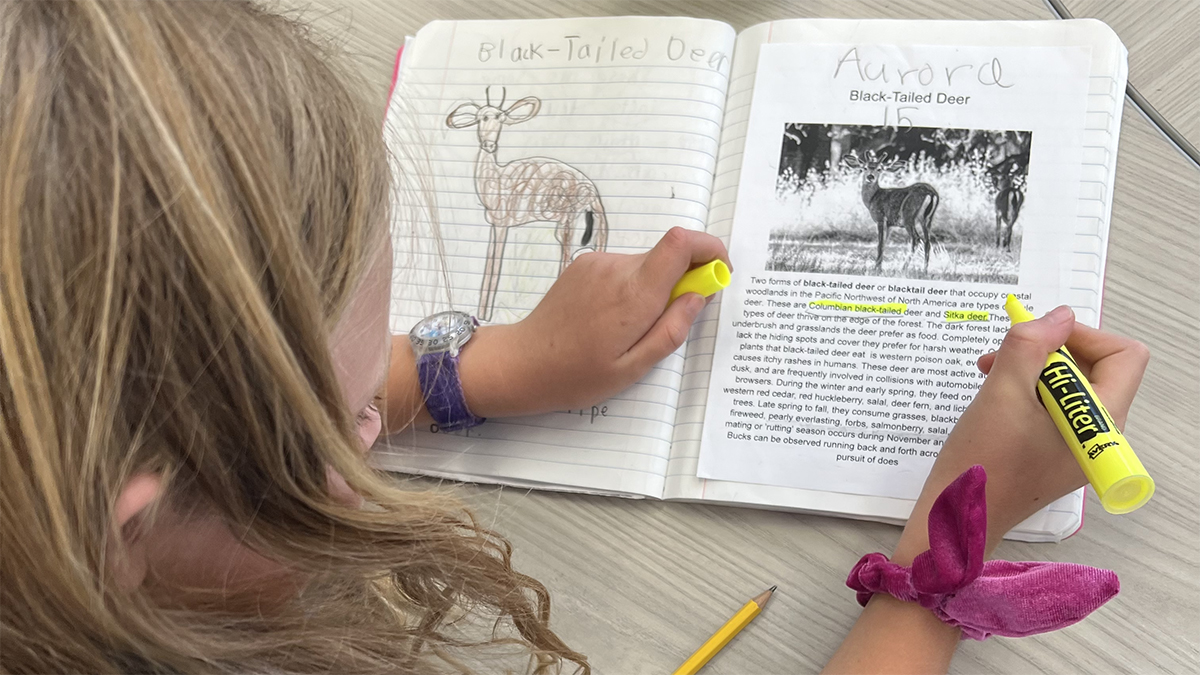feature
Designing Wildlife Crossings
A systems-thinking approach to learning about biomimicry
Janine Benyus, founder of the Biomimicry Institute, reminds us that “we live in a competent universe, we live on a brilliant planet, and we are surrounded by genius” (Biomimicry Institute n.d.). Project-based learning (PBL) that incorporates biomimicry helps students tap into this nature-inspired genius. By mimicking the structures, processes, or systems found in the living world, students discover how to learn from nature and solve human problems in sustainable ways. Once students understand the concept of biomimicry of structure, which involves copying a form like the shape of a leaf or the feet of a gecko, they can progress to mimicking a system.
Biomimicry of a system involves copying the relationships that occur between a set of interacting biological structures, like the interactions of plants and animals within an ecosystem (Biomimicry Institute n.d.). In this article, we present our work developing a Project-based Learning (PBL) unit with Next Generation Science Standards (NGSS) instructional sequences for second graders. We developed a unit in which students engaged in systems thinking to design a biomimicry solution to reduce human impact on mountain lions. Students explored the effect of a local freeway on the mountain lion population and designed land bridges to reconnect the ecosystem.
It is important to ease students into biomimicry by first considering mimicry of individual structures before diving into mimicking systems. Sharing case studies with concrete examples can get students started. This is what inspired co-author Kristen Nordstrom to write the children’s book Mimic Makers: Biomimicry Inventors Inspired by Nature (Nordstrom 2021). This book features various case studies that introduce readers to diverse inventors and their biomimicry-inspired inventions. It received the AAAS/Subaru Best STEM Picture Book award and appears on NSTA’s 2022 list of Best STEM books of the year.
Wildlife Crossing: Biomimicry of a System
This 12-week unit incorporates PBL principles from the Buck Institute (see Online Resources). The inquiry-based 5E instructional model was used to structure individual, NGSS-aligned lesson sequences.
Learning experiences were created to develop an understanding of the concept of biodiversity and the interdependent relationships in ecosystems (2-LS4-1). We facilitated the unit with our second graders at a Title 1 public school. The learners included students with special learning needs, multilingual learners, foster youth, and students with autism. The goal was to create equitable access to learning by incorporating differentiated literacy tools and high-quality STEM practices to support all learners.
This unit built on prior learning from previous lessons about plant and animal needs and interactions (2-LS2-1, 2-LS2-2). Students also applied prior learning about properties of matter (2-PS1-1, 2-PS1-3) when utilizing appropriate materials to engineer their land bridges (2-PS1-2, ETS1.A, ETS1.B, ETS1.C).
Part 1: Defining the Problem
The objectives of Part 1 were to (1) get students excited about the topic, (2) access prior knowledge, (3) introduce ecosystems and biodiversity, and (4) help students define the problem they needed to solve.
Engage
The teacher stimulated student interest and pre-assessed students by showing them a picture of a mountain lion and engaging them in a discussion to find out what they already knew about this animal and its habitat. The teacher started a class list (anchor chart) of information students knew and added new information in different colors as they learned more throughout the project.
Explore 1
The class watched footage of a local mountain lion named P-22 from the Griffith Park Trail Cam (see Online Resources) and used a See, Think, Wonder exercise (Ritchhart, Church, and Morrison 2011) to share their thoughts and observations. This helped to build student interest and empathy toward mountain lions. The teacher also shared that mountain lions have the widest geographic range of any land mammal in the Western Hemisphere. This means these animals need a lot of space to find food and a suitable mate.
The teacher asked students how they thought human structures like freeways affect mountain lions and then engaged students in a simulation. Students took turns being either a mountain lion crossing the freeway or a car driving. Afterward, students discussed how it felt to be a cougar or a driver. Students expressed feelings like “that was scary!” and “that felt really dangerous!”
When introducing real-world challenges, students can get emotionally invested in the outcome. The class discussed how this reaction shows they care. Students discussed how they can channel their concern by investigating methods to solve this problem. The driving question emerged from this dialogue, “How can second graders help mountain lions safely cross the freeway?” and students brainstormed a list of possible solutions.
Explain 1
The class read Cougar Crossing: How Hollywood’s Celebrity Cougar Helped Build a Bridge for City Wildlife by Meeg Pincus (2021). This picture book described how a mountain lion needed to safely cross freeways and introduced the students to the concept of a land bridge. Next, the class did a close read of a paragraph on mountain lions and wildlife crossings in small groups (see Online Resources). Students identified the main idea and details, defined unfamiliar vocabulary, and answered comprehension questions using sentence frames by referring to evidence in the text.
Students wondered how they could design a crossing that mountain lions would want to use. The teacher brought in a wildlife biologist to field student questions. Including local experts is a key part of making project-based learning authentic. Students learned that freeways create barriers, causing mountain lions to have less space to roam, thereby increasing the chance they will fight with one another. The class added a list of mountain lion problems to their brainstormed list of possible solutions.
The teacher encouraged students to do additional research, using leveled passages and books. The students learned how to take notes and write a report about mountain lions in their own words (Figure 1).

Mountain lion research.
Explore 2
Students investigated the parts of a mountain lion’s local environment by going on a campus scavenger hunt. The class made a list of elements in their local habitat: the Sun, puddles, wind, soil, rocks, ladybugs, oak trees, birds, worms, butterflies, etc. Students sorted their findings according to attributes—size, color, living versus nonliving, and things they thought were important for the survival of a mountain lion. This led to a discussion about how mountain lions were dependent on deer; deer were dependent on plants; and plants were dependent on water, sun, and soil for survival. We concluded our discussion by talking about how an ecosystem is a system of living and nonliving things that work together to support life.
Explain 2
The class read selected excerpts from the picture book, The Wondrous Workings of Planet Earth: Understanding Our World and Its Ecosystems by Rachel Ignotofsky (2018). Using evidence from this book, students defined ecosystems and biodiversity. They studied pictures and maps of the chaparral to learn about the characteristics of their local ecosystem and used books and pictures to compare and contrast the chaparral to other ecosystems.
Explore 3
Student teams researched a specific plant or animal from the chaparral ecosystem. These included black-tailed deer, coyotes, quail, tarantulas, mountain mahogany, yucca wiple, scrub oak, and chamise. Students learned about the unique role of each organism in the ecosystem.
Explain 3
Student teams presented their findings to the class while their classmates took notes in their science journals.
Elaborate
Students worked collaboratively to create a bulletin board model of the chaparral ecosystem based on their research from Explore/Explain 3. Their model included key plant and animal species. Students also discussed how changes to one part of the system might affect other parts. For example, if the mountain lion were to disappear, this would cause the deer population to expand and eat all the plants.
Evaluate
Students responded to the following prompt in their journals: The drought conditions in California have reduced the growth of acorns, berries, and flowers—the main food of black-tailed deer. How will this affect the mountain lion population? Some student thoughts were, “It’s cool how everything affects everything else.” and “Wow, one change can change so many other things!”
Part 2: Bridge Design
The objectives of the second 5E learning sequence were to (1) access students’ prior knowledge about properties of matter and the engineering design process and (2) introduce students to the physics of bridge building. This lesson sequence was adapted from the Designing Bridges curriculum from the Museum of Science, Boston, and shared here with permission from the museum (see Online Resources).
Engage
The teacher read the picture book Crossings: Extraordinary Structures for Extraordinary Animals by Katy S. Duffield (2020). The class discussed how land bridges mimic natural systems and have been used around the world to reconnect diverse wildlife populations. The students decided they wanted to design bridges to solve the mountain lion/freeway problem, but first, they needed to learn more about bridges.
Explore 1
Using the Designing Bridges curriculum (see Online Resources) and the book Bridges by Virginia Loh-Hagan (2017), the students investigated a suspension bridge, an arch bridge, and a beam bridge. The teacher introduced the terms span, pier, and abutment in the context of the lesson and discussed how bridges are systems in which their parts work together to achieve a design objective.
Explain 1
The class read about and discussed the job of a civil engineer, the engineering design process, and the concept of the limits or constraints of a project.
Explore 2
Students built a tower and then investigated methods to stabilize their structure against wind from a fan. For example, some students attached their tower to the ground and pulled on a string at the top to keep their tower upright. Other students explored using columns made out of rolled paper to prevent their roof from collapsing (Figure 2).

Students investigated methods to stabilize their structure in the wind.
Explain 2
The teacher engaged students in a discussion about the forces (pushes and pulls) that engineers consider when maximizing the strength and stability of structures.
Explore 3
Students built three different types of bridges (beam, arch, and deep beam) with materials including: index cards, blocks, straws, copy paper, and tape. They tested each bridge to see how much weight it could hold and recorded the data.
Explain 3
Using the data collected, the class compared and contrasted the three types of bridges tested. The class determined beam bridges are weaker than arch and deep beam bridges, and materials can be used in different ways for different reasons.
Part 3: Mimicking an Ecosystem
The objectives of the last learning sequence were to (1) access students’ prior knowledge about biomimicry and (2) provide students with an opportunity to use the engineering design process to create a real-world systems biomimicry solution.
Engage
The teacher reviewed what the students knew about bridge building by revisiting their anchor chart. Students realized that their bridge design needed to be customized to function as a wildlife crossing that mimicked the natural habitat of mountain lions. They discussed the important components their bridge would need to copy by revisiting the class model of the chaparral ecosystem. One student summarized our discussion, “Our bridge shouldn’t feel like a bridge over a big freeway. It should feel like home to a mountain lion.”
Explore 1
Students worked in teams to draw models of their designs, create budgets, gather materials, and build a prototype bridge out of recycled materials (Figure 3). Students applied what they had learned about properties of matter, bridge design, and the local chaparral ecosystem. Students were encouraged to develop ideas for how to test their bridge to determine its effectiveness.

A bridge crossing model.
Explain 1
The teacher invited a landscape architect to visit their class to provide students with real-world guidance. Students asked questions and learned the importance of using native plants to provide the right type of food for the animals using the crossing. Students also learned plants anchor soil using their deep root systems. These roots help minimize erosion and store energy so plants can resprout after a fire.
Elaborate
Students worked in teams to add representations of soil and native plants to their bridge crossings. Next, the teams used small plastic bears to test their structures for weight-bearing capacity and a shake test for stability. The teams presented their wildlife crossings to one another and used a class-developed rubric to evaluate (1) how they stayed on budget and (2) how well their design demonstrated strength and stability. The teacher coached students on how to provide constructive feedback to one another, which is an essential component of PBL. Students redesigned and retested their prototypes based on the results of their initial tests and feedback from peers.
Evaluate
Providing students with an authentic audience for their work is an essential part of PBL. Students were unable to present their projects to a live audience due to COVID-19 restrictions. Instead, students made a movie to educate their community about the plight of the local mountain lions and the importance of wildlife crossings. The teacher paid special attention to providing students with voice and choice. Each child wrote their own lines for the movie. They sent their movie to the National Wildlife Federation (NWF), which then shared it on their website. The NWF was impressed by the work of the students and commissioned a local artist named Jonathan Martinez to create several murals. These murals include a life-sized mountain lion and other endangered animals to be used for future study at the student’s school (Figure 4).

The mural!
Conclusion
Benyus once said, “Life solves its problems with well-adapted designs, life-friendly chemistry, and smart material and energy use” (Biomimicry Institute n.d.). Biomimicry is a tool that has the potential to connect young learners to this efficiency found in nature. It also offers educators the opportunity to cultivate the connection all children have with the living world to develop tomorrow’s empathic citizens and real-world problem-solvers.
Online Resources
5E Model of Instruction by the San Diego County Office of Education: https://ngss.sdcoe.net/Evidence-Based-Practices/5E-Model-of-Instruction
Biomimicry Institute n.d.: https://biomimicry.org
Biomimicry Institute: https://asknature.org
Buck Institute for Education: www.pblworks.org
Griffith Park Trail Cam YouTube: www.youtube.com/c/GriffithParkTrailCamofficial
Museum of Science, Boston EiE curriculum: https://eie.org
National Wildlife Federation: www.nwf.org
PBL Essential Elements Checklist: https://my.pblworks.org/resource/document/pbl_essential_elements_checklist
See, Think, Wonder Charts: Thinking Pathways: https://thinkingpathwayz.weebly.com/seethinkwonder.html
Kristen Nordstrom (kbottnordstrom@gmail.com) is a nationally STEM-certified educator, a nonfiction author, and lead primary teacher at Ladera STARS Academy in Thousand Oaks, California. Kristin Majda (kmajda@yahoo.com) is an adjunct faculty member at California State University Channel Islands and a science instructional specialist at Oxnard School District in Oxnard, California.
Biology Evolution Life Science Elementary



